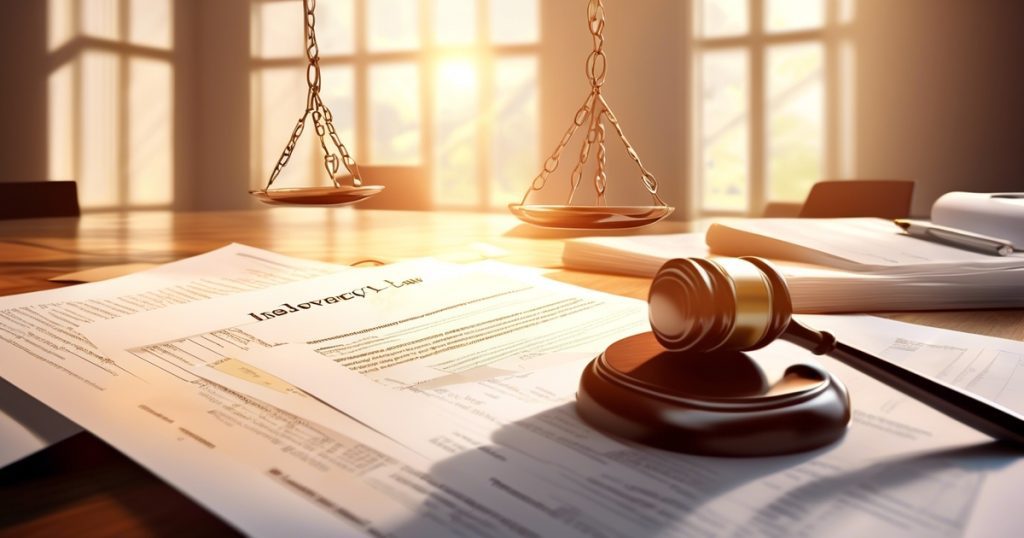Curious about the vital role of government in insolvency proceedings? Delve into this blog to understand how regulations and oversight shape restructuring, and their impact on businesses and individuals. Explore the intricate web of responsibilities defining government’s stance in insolvency matters.
Key Takeaways
- Understanding Insolvency: Government plays a crucial role in insolvency proceedings to ensure fair and orderly resolution of financial distress.
- Priority Payment Claims: Debtors should be aware of priority payment claims in insolvency, where certain creditors are entitled to be paid before others.
- Tax Obligations in Bankruptcy: Individuals or businesses facing bankruptcy must address tax obligations promptly to avoid legal complications and penalties.
- Asset Liquidation Process: The government oversees the asset liquidation process in insolvency cases to distribute funds equitably among creditors.
- Government Agencies Involvement: Various government agencies actively participate in insolvency proceedings to uphold legal regulations and protect stakeholders’ interests.
- Legal Protections for Debtors: Debtors are provided with legal protections during insolvency to ensure fair treatment and opportunities for financial recovery.
Understanding Insolvency
Basics Explained
Insolvency refers to the financial state where an individual or entity cannot meet financial obligations. The implications of insolvency can lead to legal proceedings to resolve debts. Government plays a crucial role in insolvency proceedings by regulating and overseeing the process.
Insolvency proceedings involve a series of steps to manage debt repayment. The government ensures fairness and compliance with laws throughout the process. It helps maintain stability in the financial system by providing a framework for resolving insolvency cases.
Types of Bankruptcy
Chapter 7 bankruptcy involves liquidation, where assets are sold to pay off debts. Chapter 11 bankruptcy focuses on reorganization, allowing businesses to continue operating while restructuring debts. Chapter 13 bankruptcy is for individuals with regular income seeking a repayment plan.
Liquidation bankruptcies like Chapter 7 involve selling assets to repay creditors, whereas reorganization bankruptcies like Chapter 11 aim at restructuring debt. Government involvement varies based on the type of bankruptcy as they oversee and regulate the process.
Key Terminologies
Debtor is the entity owing money, while creditor is the party owed funds. A trustee oversees the administration of bankruptcy cases. Discharge refers to the release of a debtor from personal liability for certain debts.
Preferential transfer occurs when a debtor transfers assets to favored creditors before filing for bankruptcy. Fraudulent conveyance involves transferring property or funds with intent to defraud creditors. Secured debts have collateral backing, while unsecured debts lack such security measures.
Government’s Role Overview
Regulatory Framework
The regulatory framework governing insolvency proceedings consists of laws specifically designed to manage bankruptcies. These laws outline the procedures for debt restructuring, liquidation, and reorganization. The agencies responsible for overseeing bankruptcies include regulatory bodies appointed by the government to ensure compliance with insolvency laws. These agencies play a crucial role in monitoring the insolvency process and safeguarding the interests of all stakeholders involved.
Government regulations have a significant impact on the government’s role in insolvency proceedings. By setting clear guidelines and standards, these regulations help maintain transparency and fairness in the insolvency process. They also provide a legal framework for resolving disputes between debtors and creditors, ultimately facilitating smoother insolvency proceedings.
Legal Responsibilities
Debtors and creditors involved in insolvency cases have specific legal obligations that they must adhere to throughout the process. Debtors are required to disclose accurate financial information, cooperate with appointed trustees or administrators, and comply with court orders. On the other hand, creditors must follow legal procedures when pursuing their claims, respect the rights of other creditors, and participate in meetings related to the insolvency proceedings.
Non-compliance with bankruptcy laws can have severe consequences, both for debtors and creditors. Debtors who fail to meet their legal obligations may face penalties such as asset seizure, restrictions on future financial activities, or even criminal charges in cases of fraud or misconduct. Similarly, creditors that violate bankruptcy laws risk losing their rights to claim assets from the debtor or may be subject to legal action for breaching insolvency regulations.
The government plays a critical role in enforcing legal responsibilities within insolvency proceedings. Through regulatory agencies and judicial systems, the government ensures that all parties involved comply with relevant laws and regulations. This enforcement mechanism helps maintain order, protect the rights of stakeholders, and uphold the integrity of the insolvency process.

Priority Payment Claims
Claims Due to Government
The government may hold various types of claims in insolvency cases, such as tax debts, fines, or unpaid government loans. These claims are typically given priority over other creditors due to the government’s authority and importance in ensuring public services. In bankruptcy proceedings, government claims are often treated with utmost significance and settled before other creditor claims.
Order of Priority
In insolvency proceedings, there is a specific hierarchy of creditor claims that determines the order in which they are paid. Certain types of claims, such as secured debts or employee wages, are given priority over unsecured debts. When it comes to the government’s claims, they are usually prioritized after secured creditors but before unsecured creditors.
Tax Obligations in Bankruptcy
Federal Taxes
Federal taxes play a crucial role in bankruptcy proceedings. Tax debts are typically categorized as priority claims, ensuring they are paid before other creditors. In bankruptcy cases, federal tax obligations are meticulously scrutinized to determine the extent of repayment.
During insolvency proceedings, federal tax debts are given significant importance due to their priority status. The Internal Revenue Service (IRS) closely monitors these obligations and works with the bankruptcy trustee to ensure compliance with tax laws. Any discrepancies or issues related to federal tax payments can significantly impact the outcome of the bankruptcy case.
Special considerations arise when dealing with federal tax obligations in bankruptcy. Taxpayers must provide accurate and detailed information regarding their tax liabilities to avoid potential legal consequences. Failure to address federal tax debts appropriately can lead to complications and delays in the resolution of insolvency proceedings.
State Taxes
State taxes also have a notable impact on insolvency proceedings. State tax debts are treated differently from federal tax obligations, often following state-specific regulations and guidelines. Unlike federal taxes, state tax debts may not always receive priority status in bankruptcy cases.
In bankruptcy scenarios, state tax debts are subject to varying treatment based on individual state laws. The handling of state tax obligations differs from federal taxes, leading to unique challenges for debtors seeking relief through insolvency proceedings. Understanding these distinctions is crucial for navigating the complexities of bankruptcy involving state taxes.
Differences between federal and state tax obligations further complicate insolvency proceedings. Debtors must navigate a complex landscape of regulations governing both federal and state tax debts while striving to achieve financial stability through bankruptcy. Balancing these contrasting requirements adds layers of complexity to an already intricate process.
Asset Liquidation Process
Government Assets
Government entities often possess various assets that play a crucial role in insolvency proceedings. These assets can include land, buildings, equipment, and financial investments. During bankruptcy cases, the government may utilize these assets to settle debts or generate revenue.
In insolvency scenarios, government assets are typically liquidated through auctions or sales to raise funds for creditors. This process involves valuing the assets accurately to ensure fair market value. The management of government assets in insolvency is vital as it impacts the overall recovery rate for creditors.
Public Interest Considerations
The involvement of the government in insolvency proceedings is essential to safeguard public interest. Decisions made by authorities during bankruptcies can affect various stakeholders, including employees, creditors, and the general public. Balancing public interest with individual rights is crucial for maintaining fairness and justice.
In bankruptcy cases, the government must consider economic stability, employment preservation, and social welfare when making decisions. Protecting public interest ensures that insolvency proceedings have a positive impact on society as a whole. By prioritizing public interest, the government plays a pivotal role in promoting financial integrity and social harmony.

Government Agencies Involvement
IRS in Bankruptcy
The IRS plays a crucial role in bankruptcy cases by ensuring tax debts are addressed appropriately. When it comes to insolvency, tax debts to the IRS are handled uniquely, often prioritized over other creditors. The IRS has specific procedures for filing claims and verifying the accuracy of tax debts during bankruptcies.
U.S. Trustee Program
The U.S. Trustee Program serves a vital purpose in overseeing bankruptcy cases, aiming to maintain integrity and compliance within the process. This program functions as a watchdog, monitoring bankruptcy proceedings to prevent fraud and abuse. The U.S. Trustee plays a significant role in ensuring that debtors follow bankruptcy laws and regulations diligently.
Legal Protections for Debtors
Automatic Stay Provision
The automatic stay provision in bankruptcy immediately stops creditors from pursuing debt collection actions against debtors. It gives debtors a breathing space to reorganize their financial affairs. This provision is crucial as it prevents creditors from seizing assets or filing lawsuits to collect debts. However, there are exceptions to this rule, such as cases involving certain types of debts like child support payments or criminal fines.
Exemptions and Allowances
Debtors in bankruptcy proceedings are entitled to certain exemptions, which protect specific assets from being liquidated to repay debts. These exemptions vary based on the type of asset and the jurisdiction. They ensure that debtors can maintain essential possessions like a primary residence or vehicle. allowances are provided to debtors to cover necessary living expenses during insolvency, ensuring they can meet basic needs while navigating the bankruptcy process.
Impact on Public Services
Continuity of Services
During insolvency proceedings, essential services like healthcare and utilities must continue without interruption. Bankruptcy can disrupt service providers’ operations, impacting citizens relying on these services. To maintain stability, governments implement measures ensuring the continuity of critical services during insolvency.
In such situations, service providers may face challenges in meeting their financial obligations due to bankruptcy. This can lead to potential disruptions in services, affecting the general public. To mitigate these risks, governments work closely with stakeholders to develop strategies that safeguard the provision of essential services despite financial difficulties.
Financial Repercussions
Insolvency proceedings can have significant financial consequences for governments at various levels. When businesses declare bankruptcy, it directly impacts government revenue streams through reduced tax contributions and potential job losses. Moreover, governments may need to allocate additional funds to support affected sectors during insolvency.
Bankruptcies not only affect current government spending but also have long-term implications on fiscal planning and economic stability. The loss of businesses due to insolvency can lead to decreased economic activity and investment opportunities for the government. As a result, policymakers must carefully consider the financial implications of insolvency proceedings on both short-term budgets and long-term economic growth.
Case Studies and Examples
Municipal Bankruptcies
Local governments face unique challenges in insolvency proceedings, especially in municipal bankruptcies. These cases involve cities or towns unable to pay their debts, leading to complex legal processes. Municipal bankruptcies require careful navigation due to the involvement of public services and community well-being. The impact of these proceedings can be far-reaching, affecting residents’ access to essential services like education and healthcare.
Navigating insolvency for local governments involves balancing financial obligations with the need to maintain critical services. Challenges arise when deciding which expenses to cut or restructure while ensuring public welfare. Municipal bankruptcies can lead to long-term consequences such as reduced public trust in governance and limited resources for future investments. The implications extend beyond financial matters, impacting the social fabric of communities.
Corporate Restructuring
Government intervention plays a crucial role in corporate restructuring by providing regulatory frameworks and oversight. Policies set by authorities influence how companies navigate financial distress and reorganize their operations. Government involvement can bring benefits such as stabilizing markets, protecting jobs, and fostering economic growth through strategic interventions. However, it also poses challenges like potential conflicts of interest and market distortions.
In corporate restructuring, government policies guide the process of reviving financially troubled companies through mergers, acquisitions, or debt restructuring. By setting guidelines and regulations, governments aim to ensure fairness, transparency, and stability in the business environment. Companies may benefit from government support in accessing funding or negotiating with creditors during challenging times. However, excessive interference can hinder market dynamics and innovation.
Summary
You’ve now grasped the critical role of the government in insolvency proceedings, from managing priority payment claims to overseeing asset liquidation processes. Understanding how tax obligations and legal protections for debtors intersect with public services sheds light on the intricate involvement of government agencies. Real-life case studies have exemplified these concepts, showcasing the tangible impact on both debtors and the broader economic landscape. By delving into these facets, you’ve gained insight into the complex dynamics at play in insolvency scenarios. To navigate such situations effectively, staying informed about governmental roles and regulations is crucial.
Frequently Asked Questions
What is the role of the government in insolvency proceedings?
The government plays a crucial role in insolvency proceedings by overseeing regulations, providing legal frameworks, and ensuring fair treatment for all parties involved in the process.
Are tax obligations a significant aspect of bankruptcy cases?
Yes, tax obligations are a crucial consideration in bankruptcy cases as they impact the distribution of assets to creditors and can have legal implications for debtors.
How does asset liquidation process work in insolvency cases?
Asset liquidation involves selling off a debtor’s assets to repay creditors. The process is overseen by insolvency professionals appointed by the court to ensure fair distribution of funds.
Which government agencies are typically involved in insolvency proceedings?
Government agencies such as regulatory bodies, tax authorities, and insolvency regulators play key roles in overseeing and enforcing compliance with laws and regulations during insolvency proceedings.
What legal protections are available for debtors facing insolvency?
Debtors facing insolvency are entitled to legal protections such as automatic stays on creditor actions, exemptions for certain assets, and the opportunity to propose repayment plans under bankruptcy laws.




